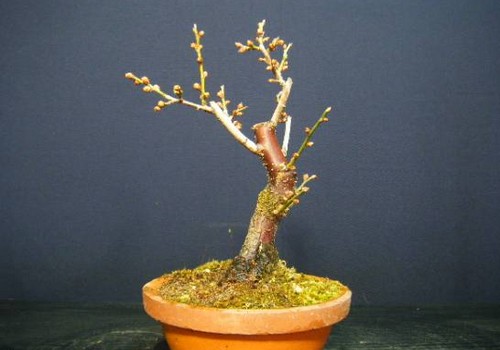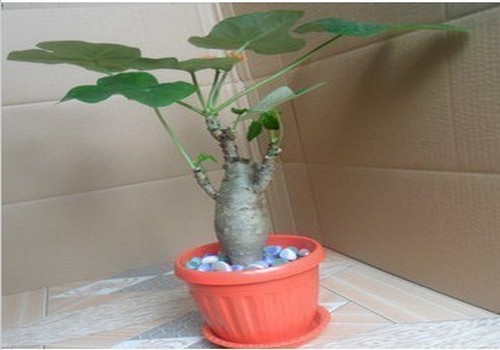The method of making five-color plum bonsai
The five-color plum used to make bonsai can be propagated by cutting, which is generally carried out in the growing season. The sturdy annual branches are cut and inserted in sand or vermiculite, and maintained under the shade shed to keep the soil and air moist. After about 40 to 50 days of rooting, the seedlings can be divided into pots. The seedlings should be planted in humus-rich and fertile soil, and the management of water and fertilizer should be strengthened after planting, so as to make the plant grow rapidly, thicken the trunk, cut off the excess branches and control the plant height in time. When the plant grows to the right size, it can be modeled. In addition, it can also be cut directly with graceful old branches, which will blossom soon after taking root. You can also choose the old pile of five-colored plum to make bonsai, its branches are vigorous and simple, with high artistry and appreciation, but this kind of pile is difficult to find, especially in the north.

The five-colored plum branches are soft and drooping, which is especially suitable for making cliff-style bonsai. In addition, it can also be processed into different forms of bonsai, such as single dry type, double dry type, oblique dry type, facing water type, dry type and so on. The leaves of five-colored plum are larger, and the crown is often chic and natural, so it is not necessary to tie it into a circular shape. Because of its rapid growth, strong germination and resistance to pruning, the modeling method should be mainly pruning, supplemented by flat binding and traction; the branches of five-colored plum are straight and can be bent with wire. It can also be modeled by the method of "cutting dry and storing branches" of the Lingnan School.
Five-colored plum is native to tropical America, and a small amount of wild plum is found in the south of China. Like warm, humid and sunny environment, not cold-resistant. Bonsai can be maintained outside in the sun during the growing season from spring to autumn, even in midsummer, but it requires good ventilation. If the light is insufficient, the plants will grow too long, the stems and branches will be thin and long, and the flowering will be rare, which will seriously affect the ornamental plants. Keep the basin soil moist during the growing period to avoid excessive dryness, and pay attention to spraying water to the leaves to increase air humidity; apply thin fertilizer dominated by phosphorus and potassium every 15 days or so to provide sufficient nutrients and make the plant blossom more. Five-color plum grows fast, so the branches and leaves that affect the shape should be cut off in time in order to maintain the beauty of the tree shape, cut the overlong twigs after each flower, and cut the plants again before entering the house at the end of autumn and the beginning of winter. In winter, if the room temperature is more than 15 ℃, the plant can grow and blossom normally, and it should be properly watered, fertilized and pruned. If it can not maintain such a high temperature, control watering, stop fertilization, and make the plant dormant, more than 8 ℃ can safely survive the winter. Turn the pot once every spring, and trim the plant again, cutting off dead branches, weak branches and other branches that affect the shape of the tree.
Potted five-color plum should turn the pot before leaving the house in spring, apply sufficient base fertilizer, and prune the branches appropriately. If it is a small seedling, it should be topped to promote lateral branches. For the formed plants, attention should be paid to the thinning of weak and diseased branches and proper truncation in order to maintain a good tree shape and promote more new shoots. If you do not leave seeds after flowering, remove the residual flowers to facilitate the extraction of inflorescences from the axils of the lower leaves, keep plenty of sunshine and moist soil during the growing period, and not be too dry, especially during flowering. If it is too dry, it is easy to wilt and affect flowering.
From May to October, cake fertilizer and water should be applied every 7 to 10 days, especially after flowering in time to keep the flowers blooming. At the end of October, to move indoors, East China can be placed in a cold room for the winter. If the indoor sunshine is sufficient, the temperature above 10 ℃ can also blossom. After entering the house, watering should be controlled and fertilization should be stopped. Overlong shoots can be properly truncated to facilitate storage.
The bonsai made by five-color plum can be maintained outside in the sun from spring to autumn, even in midsummer, but it is required to be well ventilated. If the light is insufficient, the plants will grow too long, the stems and branches will be thin and long, and the flowering will be rare, which will seriously affect the ornamental plants. Keep the basin soil moist during the growing period to avoid excessive dryness, and pay attention to spraying water to the leaves to increase air humidity; apply thin fertilizer dominated by phosphorus and potassium every 15 days or so to provide sufficient nutrients and make the plant blossom more.
Five-color plum grows fast, so the branches and leaves that affect the shape should be cut off in time in order to maintain the beauty of the tree shape, cut the overlong twigs after each flower, and cut the plants again before entering the house at the end of autumn and the beginning of winter.
If the room temperature above 15 ℃ is maintained in the sunny part of the room in winter, the plant can grow and blossom normally, and it should be watered, fertilized and pruned properly. If you can not maintain such a high temperature, control watering, stop fertilization, so that the plant dormancy, more than 8 ℃ can safely survive the winter. Turn the pot once every spring, and trim the plant again, cutting off dead branches, weak branches and other branches that affect the shape of the tree.
Time: 2019-05-26 Click:
- Prev

The method of making bonsai of Berberis amurensis
Red leaf Berberis is a deciduous shrub with reddish brown branches and leaves, light and shade tolerance, lax soil requirements, strong sprouting power and resistance to pruning, so it is one of the greening tree species in northern China. In the garden, the color arrangement is often made with evergreen trees, which can be used to arrange flower beds and flower mirrors. it is an important tree species for color block combination in landscaping.
- Next

Key points of bonsai production of Buddha belly tree
Buddha belly tree is a succulent plant of Euphorbiaceae. The stem is short and fat, fleshy, and the base is inflated, like the belly of Maitreya Buddha, hence the name. Leaves palmately peltate-3-lobed, with large leaf scars. Flowers gather at the top of the branch, orange-red, five-petal, pedicel branches like red coral, so it is also known as coral flowers. Because of its unique shape and bright colors.
Related
- Fuxing push coffee new agricultural production and marketing class: lack of small-scale processing plants
- Jujube rice field leisure farm deep ploughing Yilan for five years to create a space for organic food and play
- Nongyu Farm-A trial of organic papaya for brave women with advanced technology
- Four points for attention in the prevention and control of diseases and insect pests of edible fungi
- How to add nutrient solution to Edible Fungi
- Is there any good way to control edible fungus mites?
- Open Inoculation Technology of Edible Fungi
- Is there any clever way to use fertilizer for edible fungus in winter?
- What agents are used to kill the pathogens of edible fungi in the mushroom shed?
- Rapid drying of Edible Fungi

